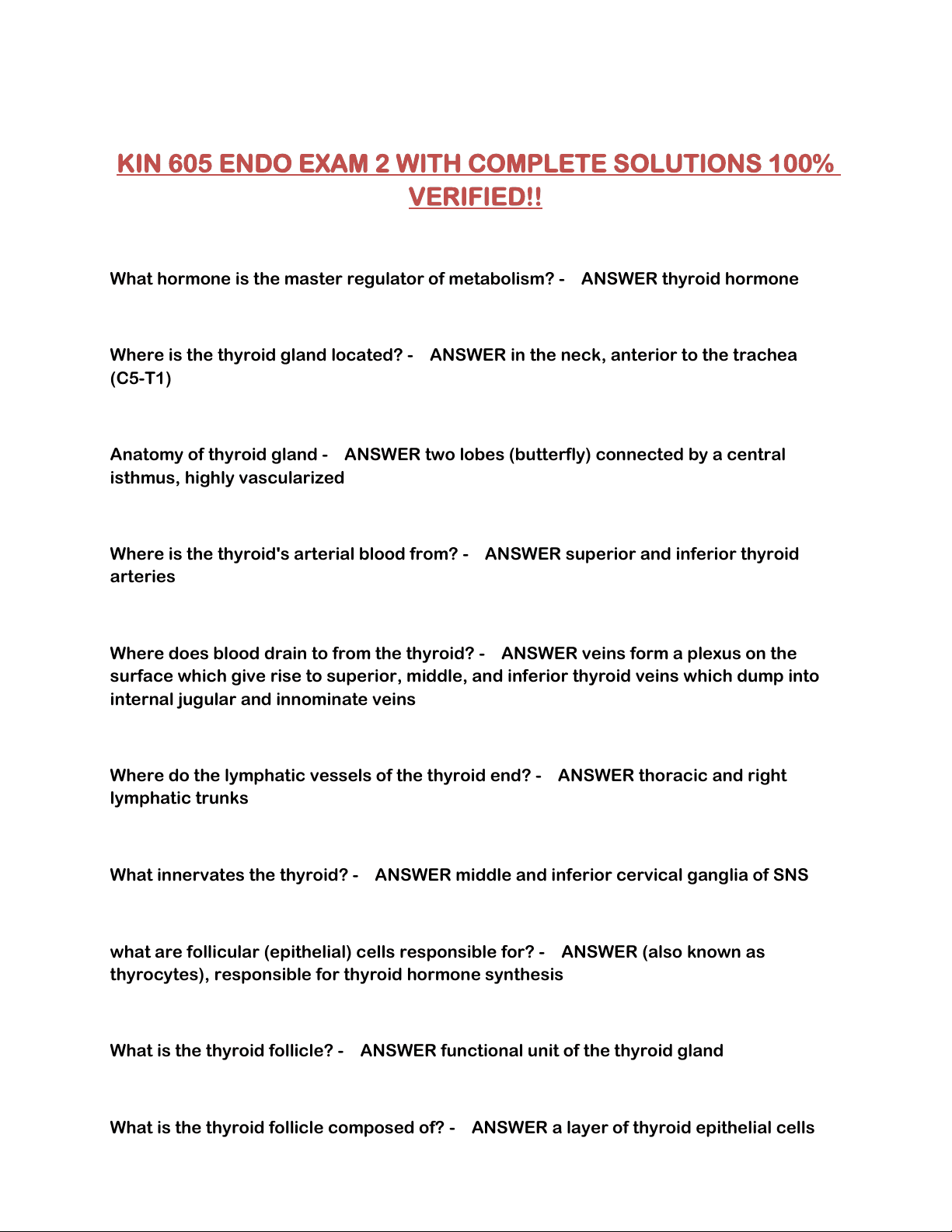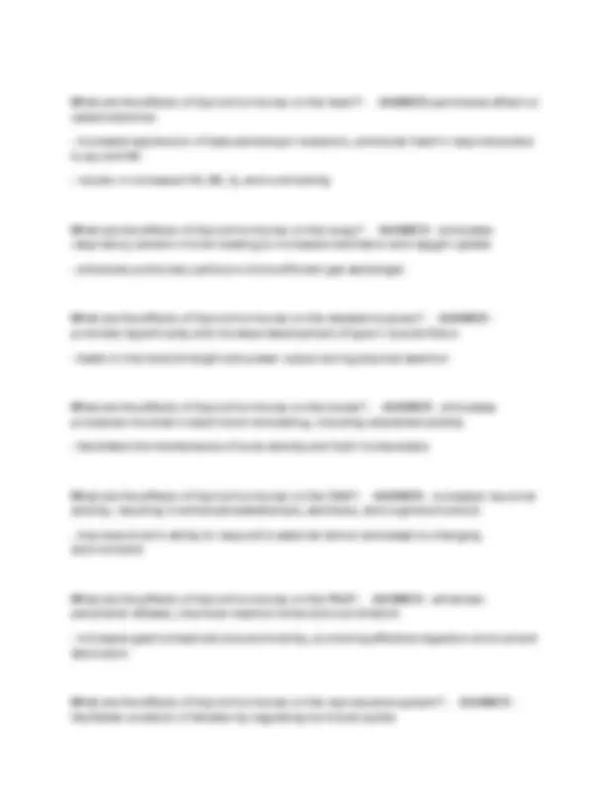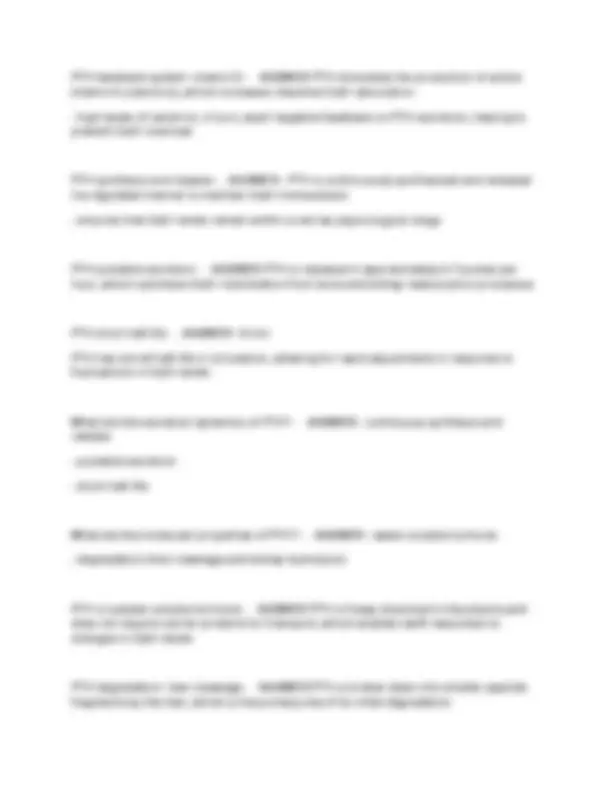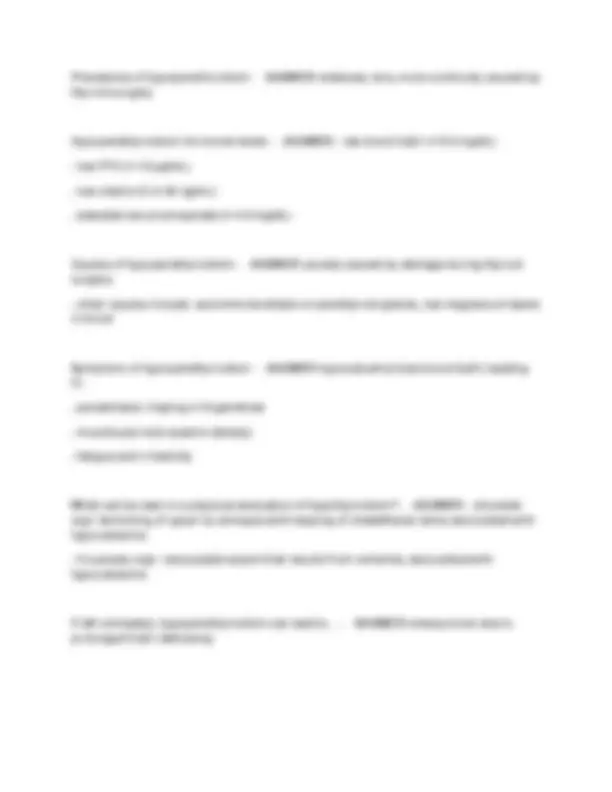























Study with the several resources on Docsity

Earn points by helping other students or get them with a premium plan


Prepare for your exams
Study with the several resources on Docsity

Earn points to download
Earn points by helping other students or get them with a premium plan
Community
Ask the community for help and clear up your study doubts
Discover the best universities in your country according to Docsity users
Free resources
Download our free guides on studying techniques, anxiety management strategies, and thesis advice from Docsity tutors
A comprehensive overview of thyroid hormone regulation and function, covering key aspects like synthesis, transport, metabolism, and effects on various organ systems. It includes detailed explanations of the hypothalamic-pituitary-thyroid (hpt) axis, thyroid hormone receptors, and the impact of thyroid hormone imbalances. The document also explores the role of thyroid hormones in growth, development, metabolism, and cardiovascular function. It is a valuable resource for students studying endocrinology, physiology, or related fields.
Typology: Exams
1 / 29

This page cannot be seen from the preview
Don't miss anything!






















What hormone is the master regulator of metabolism? - ANSWER thyroid hormone
Where is the thyroid gland located? - ANSWER in the neck, anterior to the trachea (C5-T1)
Anatomy of thyroid gland - ANSWER two lobes (butterfly) connected by a central isthmus, highly vascularized
Where is the thyroid's arterial blood from? - ANSWER superior and inferior thyroid arteries
Where does blood drain to from the thyroid? - ANSWER veins form a plexus on the surface which give rise to superior, middle, and inferior thyroid veins which dump into internal jugular and innominate veins
Where do the lymphatic vessels of the thyroid end? - ANSWER thoracic and right lymphatic trunks
What innervates the thyroid? - ANSWER middle and inferior cervical ganglia of SNS
what are follicular (epithelial) cells responsible for? - ANSWER (also known as thyrocytes), responsible for thyroid hormone synthesis
What is the thyroid follicle? - ANSWER functional unit of the thyroid gland
What is the thyroid follicle composed of? - ANSWER a layer of thyroid epithelial cells
surrounding a large central cavity filled with colloid
How much of the thyroid gland mass does the colloid account for? - ANSWER accounts for ~30% of thyroid gland mass
What are the contents of the colloid? - ANSWER contains thyroglobulin (Tg), a protein crucial for hormone synthesis
What way does the apical surface of follicular cells face and what are they involved in? - ANSWER faces follicular lumen, involved in colloid storage ("inward")
What way does the basolateral surface of follicular cells face? - ANSWER faces interstitium, allowing exposure to the circulation ("outward")
How is the thyroid-stimulating hormone (TSH) transported? - ANSWER transported in bloodstream from the anterior pituitary to thyroid gland
What does TSH bind to? - ANSWER binds to TSH G-protein-coupled receptor located on basolateral membrane of follicular cells
Na+/I- symporter function - ANSWER transports and concentrates iodide within epithelial cells
Na+/I- symporter mechanism - ANSWER - transports one I- ion against its gradient while simultaneously transporting two Na+ ions down their electrochemical gradient from the extracellular fluid (ECF) into the cell
Na+/I- symporter energy source - ANSWER secondary active transport relies on the Na+/K+ ATPase, which maintains low intracellular Na+ levels
What are other inhibitors of thyroid hormone? - ANSWER somatostatin, glucocorticoids, dopamine
What stimulates thyroid hormones? - ANSWER cold exposure, stress, exercise
Effects of thyroid hormones - ANSWER affect nearly every organ system in the body, primarily genomic effects (alters transcription and translation factors)
What type of receptors are thyroid hormone receptors? - ANSWER nuclear receptors
How do thyroid hormone receptors function in the cell? - ANSWER act as DNA-binding transcription factors
What is the role of thyroid hormone receptors in gene expression? - ANSWER serve as molecular switches that respond to hormone binding, regulating gene expression
How do thyroid hormones affect growth? - ANSWER growth formation, bone maturation
How do thyroid hormones affect the CNS? - ANSWER maturation of CNS
How do thyroid hormones affect BMR? - ANSWER increased Na+/K+ ATPase activity, increased O2 consumption, increased heat production, increased BMR
How do thyroid hormones affect metabolism? - ANSWER increased glucose absorption, increased glycogenolysis, increased gluconeogenesis, increased lipolysis, increased protein synthesis and degradation (net catabolic)
How do thyroid hormones affect cardiovascular? - ANSWER increased Q, HR, SV, and contractility
What are the effects of thyroid hormones on the heart? - ANSWER permissive effect on catecholamines
What are the effects of thyroid hormones on the lungs? - ANSWER - stimulates respiratory centers in brain leading to increased ventilation and oxygen uptake
What are the effects of thyroid hormones on the skeletal muscles? - ANSWER - promotes hypertrophy and increase development of type II muscle fibers
What are the effects of thyroid hormones on the bones? - ANSWER - stimulates processes involved in adult bone remodeling, including osteoblast activity
What are the effects of thyroid hormones on the CNS? - ANSWER - increases neuronal activity, resulting in enhanced wakefulness, alertness, and cognitive function
What are the effects of thyroid hormones on the PNS? - ANSWER - enhances peripheral reflexes, improves reaction times and coordination
What are the effects of thyroid hormones on the reproductive system? - ANSWER - facilitates ovulation in females by regulating hormonal cycles
formation of glucose from non-carbohydrate precursors in the liver, supporting blood sugar levels
Effect of thyroid hormones on glycogenolysis - ANSWER increased: stimulates the breakdown of glycogen into glucose, providing a quick source of energy when needed
After experiencing significant head trauma, how might damage to the hypothalamus or pituitary gland affect thyroid function, and what symptoms could arise from these disruptions in hormone regulation? - ANSWER damage to the HPT axis, decrease in function can lead to symptoms of hypothyroidism (fatigue, cold, weight gain)
T/F All hypothalamic releasing and inhibiting factors are mediated via G-protein coupled receptors - ANSWER true
What are the causes of hypothalamic disorders? - ANSWER tumors (benign or malignant), TBI, genetic disorders (e.g., Prader-Willi syndrome, Kallmann syndrome), infections (e.g., meningitus, encephalitis), radiation therapy or surgery near hypothalamus, vascular disorders (e.g., stroke), diabetes insipidus
What are hypothalamic tumors? - ANSWER abnormal growths affecting the hypothalamus
Symptoms of hypothalamic tumors - ANSWER - altered hormone regulation (affecting thyroid, adrenal, gonads)
Treatment of hypothalamic tumors - ANSWER surgery, radiation, or chemotherapy (depending on tumor type), hormone replacement therapy
Description of Kallmann syndrome - ANSWER a genetic disorder causing failure of
hypothalamic release of GnRH, leading to hypogonadism
Symptoms of Kallmann syndrome - ANSWER - delayed or absent puberty
Treatment of Kallmann syndrome - ANSWER hormone replacement therapy (testosterone or estrogen/progesterone) to induce puberty and manage fertility
Description of diabetes insipidus - ANSWER deficiency in ADH affecting the kidneys' ability to conserve water
Symptoms of diabetes insipidus - ANSWER - excessive thirst (polydipsia)
Causes of diabetes insipidus - ANSWER - lack of AVP/ADH production
Treatment of diabetes insipidus - ANSWER desmopressin (synthetic ADH)
Diabetes insipidus effect on urine volume - ANSWER abnormally large volumes of urine, ≥ 30 mL/kg body weight per day (normal = 1-2 mL/kg/hour)
Diabetes insipidus effect on urine osmolality - ANSWER dilute urine, urine osmolality < 250 mOsm/kg (normal = > 500 mOsm/kg)
What does dilute urine indicate in diabetes insipidus? - ANSWER the kidneys are
enlargement of hands, feet, and facial features; and insulin resistance
What can GH-producing adenomas lead to? - ANSWER can lead to acromegaly (in adults) or gigantism (in children)
ACTH-producing adenoma - ANSWER overproduction of ACTH stimulates adrenal cortex to secrete excess cortisol
Effect of ACTH-producing adenoma on endocrine system - ANSWER excess cortisol results in fat redistribution (moon face, buffalo hump), muscle wasting, and immune suppression
What can ACTH-producing adenomas lead to? - ANSWER Cushing's disease (excess cortisol)
Symptoms of pituitary adenomas - ANSWER hormonal imbalance, vision problems, headaches, infertility, and irregular menstruation
Treatment of pituitary adenomas - ANSWER medications, surgery, radiation therapy
What medications are used for pituitary adenomas? - ANSWER - dopamine agonists (e.g., cabergoline) reduce prolactin levels in prolactinomas
Description of hypopituitarism - ANSWER underactivity of the pituitary gland leading to deficiencies in one or more pituitary hormones
Causes of hypopituitarism - ANSWER pituitary adenomas, head trauma, surgery, radiation therapy, or infections
Symptoms of hypopituitarism - ANSWER fatigue, weakness, weight loss, and low BP
(depends on hormone deficiency)
Treatment of hypopituitarism - ANSWER hormone replacement therapy (HRT) for the deficient hormones
What are the hormone - ANSWER
What endocrine gland does ACTH regulate? - ANSWER adrenal cortex (cortisol production)
What endocrine gland does TSH regulate? - ANSWER thyroid glands (T3 and T production)
What endocrine gland does LH/FSH regulate? - ANSWER gonads (testosterone, estrogen, progesterone production)
What endocrine gland does GH regulate? - ANSWER growth and metabolic regulation (via IGF-1)
Symptoms of GH deficiency in children - ANSWER short stature and delayed growth (dwarfism)
Symptoms of GH deficiency in adults - ANSWER reduced muscle mass, fatigue, and metabolic issues (e.g., increased fat)
Symptoms of ACTH deficiency (secondary adrenal insufficiency) - ANSWER reduced
Symptoms of hypothyroidism - ANSWER fatigue, weight gain, cold intolerance, dry skin, depression, and slowed HR
Diagnosis of hypothyroidism - ANSWER - blood tests to measure TSH, free T4, and sometimes free T
Other indicators of hypothyroidism (outside of blood tests/antibodies) - ANSWER - elevated cholesterol and lipid levels (due to decreased metabolism)
Treatment on hypothyroidism - ANSWER - levothyroxine (synthetic T4), dose adjusted based on serum TSH levels
Description of hyperthyroidism - ANSWER overactive thyroid with excessive thyroid hormone production accelerating metabolic processes
Common causes of hyperthyroidism - ANSWER Graces' disease, toxic nodule goiter, thyroiditis
What is happening hormonally with hyperthyroidism? - ANSWER - increased T3/T levels suppress TSH due to enhanced negative feedback
Hyperthyroidism hormonal profile - ANSWER low TSH with high T3/T
Graves' disease - ANSWER autoimmune condition where antibodies stimulate the thyroid
Symptoms of hyperthyroidism - ANSWER weight loss, heat intolerance, nervousness, rapid heartbeat, and increased sweating
Diagnosis of hyperthyroidism - ANSWER based on hormone levels, imaging (ultrasound, radioactive iodine uptake), and antibody testing in Graves' disease
Treatment of hyperthyroidism - ANSWER antithyroid medications, radioactive iodine, or thyroidectomy
Description of thyroid nodules/cancer - ANSWER abnormal growths on thyroid, some of which may be cancerous (most are benign)
Symptoms of thyroid nodules/cancer - ANSWER lump in the neck, trouble swallowing, hoarseness, and in some cases, hormonal imbalance
Types of thyroid cancer - ANSWER papillary (most common), follicular, medullary, and anaplastic thyroid cancers
Diagnosis of thyroid cancer - ANSWER fine-needle aspiration biopsy, thyroid function tests, and imaging
Treatment of thyroid nodules/cancer - ANSWER observation (for benign nodules), surgery, radioactive iodine, or thyroid hormone therapy
What are the two primary thyroid hormones? - ANSWER triiodothyronine (T3) and thyroxine (T4)
What do the thyroid hormones do? - ANSWER regulate metabolism, growth, temperature regulation, and protein synthesis
Which thyroid hormone is converted in the periphery? - ANSWER T4 is converted to the more active form T3 in the peripheral tissues
free T3: low or normal
What do the abnormal hormone levels of secondary hypothyroidism indicate? - ANSWER issue at the level of the pituitary or hypothalamus causing insufficient stimulation of the thyroid
What are the abnormal hormone levels for primary hyperthyroidism? - ANSWER TSH: low (usually < 4.0 mlU/L)
free T4: high (> 2.0 ng/dL)
free T3: high (> 4.2 pg/mL)
What do the abnormal hormone levels of primary hyperthyroidism indicate? - ANSWER excessive thyroid hormone production, suppressing TSH through negative feedback
What are the abnormal hormone levels for subclinical hyperthyroidism? - ANSWER TSH: low
free T4: normal
free T3: normal
What do the abnormal hormone levels of subclinical hyperthyroidism indicate? - ANSWER early or mild form of hyperthyroidism where only TSH is suppressed, but T and T4 remain within the normal range
Which endocrine disorder is the most prevalent globally? - ANSWER hypothyroidism
Thyroid disorders are most common in... - ANSWER women and older adults
T/F Hyperthyroidism is very common. - ANSWER False, hyperthyroidism is relatively rare (unless with TBI)
What mechanisms might explain the increased risk of endocrine comorbidities, such as adrenal insufficiency and pituitary dysfunction, following TBI? - ANSWER - swelling in the brain puts pressure on capillaries and can restrict blood to the HPA axis
How does the severity of TBI (mild vs. moderate-to-severe) affect the development of endocrine and cardiovascular comorbidities? - ANSWER not much difference, if any, between symptoms and comorbidities of mild and moderate-to-severe TBIs
Why might younger individuals with TBI show higher risk for certain conditions like diabetes and hypertension? - ANSWER - still in development, still relying on hormone use
What are the possible long-term health implications of adrenal insufficiency after TBI and how might it contribute to increased mortality in patients with moderate-to-severe TBI? - ANSWER - lack of NE and Epi can lead to dysregulation of vascular resistance and tone (lead to CVD)
Sarah case study:
TSH: 1.5 mlU/L
Free T4: 1.2 ng/dL
Free T3: 3.0 pg/mL
Symptoms: hypertension, sleep disturbance - ANSWER no thyroid related problems (all within normal range)
Maria case study
TSH: 0.2 mlU/L
How do thyroid hormones affect muscle fiber types? - ANSWER promote a shift from slow-twitch (type I) to fast-twitch (type II) muscle fibers
Which enzyme is primarily responsible for the local activation of thyroid hormone in skeletal muscle? - ANSWER type 2 iodothyronine deiodinase (DIO2)
What is the relationship between thyroid hormone levels and skeletal muscle energy expenditure? - ANSWER thyroid hormones increase both the glycolytic and oxidative capacities of muscle
Where is the parathyroid located? - ANSWER on the top and bottom posterior borders of the lateral lobs of the thyroid glands
What are the cell types of the parathyroid hormone? - ANSWER chief cells and oxyphil cells
What is the function of chief cells in parathyroid? - ANSWER responsible for production and secretion or parathyroid hormone (PTH)
What is the function of the parathyroid hormone (PTH? - ANSWER primary regular of Ca2+ homeostasis
What are the characteristics of chief cells in an inactive state (normal Ca2+ levels)? - ANSWER small golgi apparatus, high glycogen stores, low # of secretory granules
What are the characteristics of chief cells in an active state (low Ca2+ levels)? - ANSWER enlarged golgi apparatus to enhance PTH synthesis and secretion, reduced glycogen stores, increased # of secretory granules containing PTH
Oxyphil cells - ANSWER function unknown, may play role in glandular health or PTH regulation
What are the effects of PTH on the bone? - ANSWER stimulates bone remodeling by increasing osteoclast activity, leading to Ca2+ release into bloodstream
What is the effect of PTH on the kidneys? - ANSWER promotes Ca2+ reabsorption in the renal tubules while decreasing phosphate reabsorption
What is the effect of PTH on vitamin D? - ANSWER stimulates the conversion of inactive vitamin D to its active form (calcitriol) which increases intestinal Ca2+ absorption
What is the importance of PTH? - ANSWER maintains Ca2+ homeostasis, supports bone health, and enhances kidney and vitamin D function
PTH importance in maintaining Ca2+ homeostasis - ANSWER PTY ensures stable blood Ca2+ levels, which are essential for proper nerve signaling, muscle contraction, and cellular processes
PTH importance in supporting bone health - ANSWER by regulating bone remodeling, PTH balances Ca2+ release and deposition, maintaining bone strength and density
PTH importance in enhancing kidney and vitamin D function - ANSWER PTH promotes Ca2+ reabsorption in the kidneys and activates vitamin D, optimizing Ca2+ absorption from the gut and preventing calcium deficiency
Critical functions/importance of plasma Ca2+ regulation - ANSWER normal cellular activity, neural transmission, membrane stability, bone structure, blood coagulation, and intracellular signaling
Importance of plasma Ca2+ regulation on normal cellular activity - ANSWER ensures proper enzymatic function and metabolic processes
Importance of plasma Ca2+ regulation on neural transmission - ANSWER essential for neurotransmitter release and nerve impulse propagation